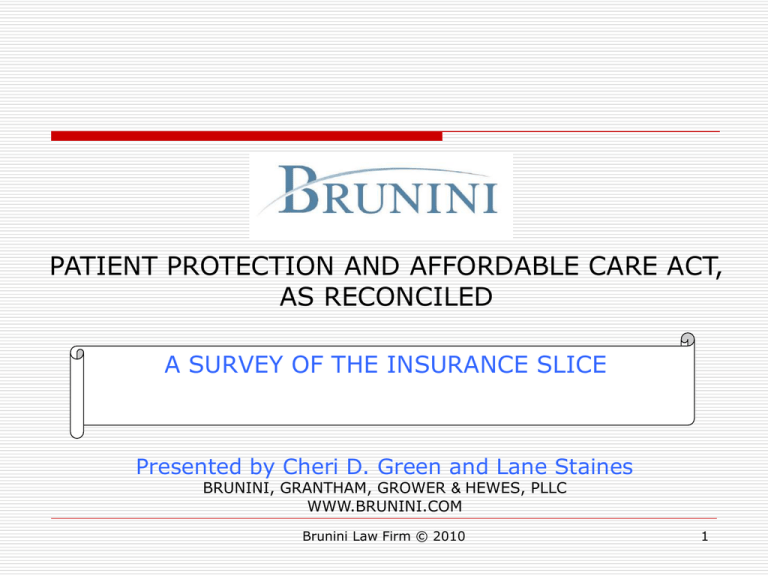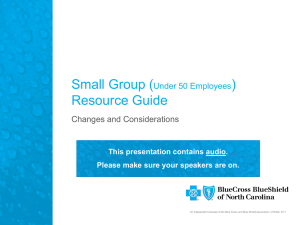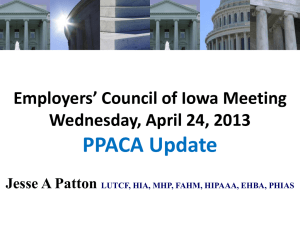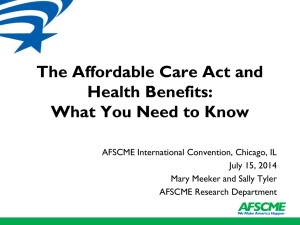A Survey of the Insurance Slice
advertisement

PATIENT PROTECTION AND AFFORDABLE CARE ACT, AS RECONCILED A SURVEY OF THE INSURANCE SLICE Presented by Cheri D. Green and Lane Staines BRUNINI, GRANTHAM, GROWER & HEWES, PLLC WWW.BRUNINI.COM Brunini Law Firm © 2010 1 PPACA Brunini Law Firm © 2010 2 Effective Dates Brunini Law Firm © 2010 3 INSURANCE REFORM COVERAGE Brunini Law Firm © 2010 4 Grandfathered Plans "Preservation of right to maintain existing coverage" aka Grandfathered Plans. No one is required to terminate participation in group coverage. Subtitle A (Immediate Improvements in Health Care Coverage for all Americans) and Subtitle C (Quality Health Insurance Coverage for All Americans) do not apply to grandfathered plans. Except the specific Minimum Loss Ratio provision and uniform coverage provisions (e.g. no pre-existing condition, no excessive waiting periods, lifetime and annual limits, prohibition on rescission, coverage of dependents through age 26, uniform explanation of coverage reports etc.). Brunini Law Firm © 2010 5 Grandfathered Plans There is no “sunset” for Grandfathered Plans in the legislation. However, it is unlikely that such will be allowed to exist in perpetuity. PPACA provides for Grandfathered Plans that do not change their coverage. Thus, expect regulations as to what would constitute a change so as to disqualify “grandfathered” status. Brunini Law Firm © 2010 6 Dependent Coverage Includes married Dependent coverage for “children” up to age 26. Applies to grandfathered plans for plan years 6 months after enactment and before 1/1/14, if the "child" is not eligible for another employer-sponsored plan. Also note tax exclusion for employer provided benefits for person who was not age 27 at the end of the taxable year [HCERA 1004(d)]. Technically 9/23/10 but for Plan years beginning after effective date so look to 1/1/11. Brunini Law Firm © 2010 7 Pre and Post 2014 Differences Annual Limits Restricted annual limits on "essential health benefits" for plan years pre 1/1/14. No annual limits at all beginning 1/1/14. [Caveat for "per beneficiary" annual limits for non essential health benefits - can place limits on specific benefits if otherwise allowed under federal or state laws]. Applies to grandfathered plans. Technically 9/23/10 but for Plan years beginning after effective date 1/1/11. Brunini Law Firm © 2010 8 Lifetime Limits No lifetime limits. [Caveat for "per beneficiary" lifetime limits for nonessential health benefits, if otherwise permitted by federal or state laws]. Applies to grandfathered plans. Technically 9/23/10 but for Plan years after effective date so look to 1/1/11. Brunini Law Firm © 2010 9 Non-Discrimination Existing non-discrimination rules in favor of highly compensated employees now apply also to group insured plans. Subject to tax on excess reimbursement of medical reimbursement plan. Self-funded plans subject to prohibition since 1980s Technically 9/23/10 but for Plan years after effective date so look to 1/1/11. Does not apply to grandfathered plans. Brunini Law Firm © 2010 10 Pre-Existing Conditions X No pre-existing condition exclusions for “children” under age 19 through 12/31/2013. Applies to grandfathered plans. Technically 9/23/10 but for Plan years beginning after effective date so look to 1/1/11. Effective 1/1/14 no Pre-X regardless of age. Brunini Law Firm © 2010 11 High Risk Pool High Risk Insurance Pool to be established by HHS [through 1/1/14]. Eligible if 1) U.S. Citizen or in the U.S. lawfully; 2) not covered under creditable coverage during 6 months before application date; and, 3) has a preexisting condition. $5 Billion available from HHS to play claims (and administrative costs) that exceed premiums collected. Plan must cover 65% of health care costs for "standard" population. Premiums not yet determined. * On April 2, 2010 HHS gave States choice of operating under certain options or do nothing, and the HHS would run it. Plans that encourage individuals to de-enroll could be liable to reimburse Pool for medical expenses. Effective 6/21/2010. Brunini Law Firm © 2010 12 Rescission Prohibits rescission of coverage except for fraud or intentional misrepresentation. Applies to grandfathered plans. Technically 9/23/10 but for Plan years beginning after effective date so look to 1/1/11. Brunini Law Firm © 2010 13 Preventive Services Coverage for certain preventive services and immunizations without cost-sharing requirement. [For example, no deductible or co-pay for vaccines.] Includes preventative care and screenings set forth in Health Resources and Services Administration [such as breast cancer screening and mammograms, etc.] Does not apply to grandfathered plans. Technically 9/23/10 but for Plan years beginning after effective date so look to 1/1/11. Brunini Law Firm © 2010 14 Patient Protections Patient Protections requirements: if required to designate primary care physician, then allowed to select any that is available to accept; allows choice of pediatrician as child's primary care physician; women allowed to choose a participating OB/GYN without referral; emergency services without preauthorization and treat as in network. Does not apply to grandfathered plans. Technically 9/23/10 but for Plan years beginning after effective date so look to 1/1/11. Brunini Law Firm © 2010 15 MLVs Minimum Loss Ratios: Rebates required if minimum loss ratios [general premium to benefits] are not met. [80% Small Groups and Individuals and 85% Large Groups] Applies to grandfathered plans but not selffunded plans. Technically 9/23/10 but for Plan years beginning after effective date so look to 1/1/11. Brunini Law Firm © 2010 16 Limited Waiting Period No waiting period in excess of 90 days for employer plans. Includes grandfathered plans. Effective Year 2014. Brunini Law Firm © 2010 17 Guaranteed Guaranteed renewability of coverage [exceptions for not paying premium, policy no longer offered in the market, etc] Guaranteed Issue ["Guaranteed Availability of Coverage" and "Prohibiting Discrimination Against Individuals Participants and Beneficiaries Based on Health Status"] for all individual and group plans. Does not apply to grandfathered plans. Effective Year 2014 Brunini Law Firm © 2010 18 Appeal Procedures Claim Appeal Procedures - comply with appeal procedures in place at time of enactment [and when updated]. Applies to Internal and External appeal procedures. Notify participant of appeal rights in a “culturally and linguistically appropriate” manner and right to review file and present evidence. Mississippi has no external appeal regulations. Brunini Law Firm © 2010 19 Internal and External Appeals Internal External -existing DOL -future DOL -self-funded existing State or Uniform External Review Model Act and future DOL -insured existing and future DOL Brunini Law Firm © 2010 20 Clinical Trials 2014 Qualified Individual is one with cancer or other life threatening disease referred by network provider or who otherwise provides evidence for participation. Must participate in network trial, if available If Plan does not cover out of network services, then Plan not required to cover out of network clinical trial. Covers routine costs of clinical trial items and services typically covered under the Plan for those not participating. Does not cover cost of the investigational device or data gathering. Brunini Law Firm © 2010 21 Deductibles Small group market - deduction limitations $2000 individual and $4000 “other” with formula increase after 2014. May be increased by maximum amount of reimbursement which is reasonably available under FSAs. Does not apply to grandfathered plans. Effective Year 2014. Brunini Law Firm © 2010 22 Premium Controls "Value for Dollars" requires premium rate review - for unreasonable rate increases. Provides grants to States to review premiums and Medical Reimbursement Data Centers created to review rates. State may recommend health insurance issuers be excluded from the "American Health Benefit Exchange" aka Exchange if they have a history of "unjustified" premiums. Brunini Law Firm © 2010 23 "American Health Benefit Exchange“ Insurance Carriers Not for Profit CO-OPS Individuals and Groups Brunini Law Firm © 2010 24 The Exchange 2014 "American Health Benefit Exchange," aka Exchange, are to be operational in each State [must include "Small Business Health Options Program" [SHOP] or have a separate SHOP Exchange]. Exchanges must include - at least 2 MultiState Qualified Health Plans to be offered in each State Exchange [at least one must be non-profit]. Exchanges must include at least one "COOP Plan," if they offer qualified health plan. Must be not-for-profit. Brunini Law Firm © 2010 25 Exchange Status HHS to determine by 1/1/13 whether a State's Exchange will be operational by 1/1/14. If not, HHS has authority to take actions as are necessary to establish and operate such Exchange and take such actions as are necessary to implement such other requirements. Brunini Law Firm © 2010 26 Qualified Health Plan General definition of a "Qualified Health Plan" Q.H.P. = 1) Certified; 2) Provides Essential Health Benefits Package (a. Essential Health Benefits b. Limits cost sharing c. Provides Bronze, Silver, Gold or Platinum plans); and, 3) Offered by health insurance issuer who a) is licensed in the State; b) agrees to offer at least one Q.H.P. in Silver and in Gold; c) charges same premium for Q.H.P. whether offered in Exchange, directly through the issuer/agent; and, d) follows all other regulations applicable to Exchanges in the PPACA and as later may be established. An Essential Health Benefits Package does not have to include abortion services §1303(a)(1)(A)(i). Self-funded plans and MEWAs not included in Q.H.P. regulations. Brunini Law Firm © 2010 27 Essential Health Benefits Essential Health Benefits established aka Minimum Essential Coverage from essential health benefits: (A) Ambulatory Patient Services; (B) Emergency Services; (C) Hospitalization; (D) Maternity and Newborn care; (E) Mental health and substance use disorder services, including behavioral health treatment; (F) Prescription Drugs; (G) Rehabilitation and habilitative services and devices; (H) Laboratory Services; (I) Preventive and wellness services and chronic disease management; and, (J) Pediatric services, including oral and vision care [can have a stand alone Dental Plan- PPACA §1311(d)(2)(B)(ii)] WATCH FOR HHS REGULATIONS Brunini Law Firm © 2010 28 Who is Qualified? Qualified Individual for a Q.H.P. : 1) seeks to enroll in a QHP and 2) resides in that State. Does not include those in jail. Qualified Employer for a Q.H.P. : Small Employer is one who elects to make all Full Time Employees, as defined, eligible for one or more Q.H.P.s offered in the Small Market Group in the Exchange. Will include Large Employers, if State opts to allow their participation, in 2017. §1312(f)(2)(A) and (B) Brunini Law Firm © 2010 29 Plans in the Exchange Defines Bronze, Silver, Gold and Platinum Levels in terms of actuarial value of benefits (60%, 70%, 80% and 90%). Child-Only Plans: A Q.H.P. at any level must be offered as a separate Plan for individuals less than 21 yrs. Catastrophic Plan: A catastrophic plan is offered in individual market for those under 30 before the beginning of the Plan Year or for those who meet certain hardship or uninsured requirements. Must offer at least three primary care visits. No "essential health benefits" coverage until certain cost-sharing requirements are met. Exchange Qualified Health Plans must be equal to scope of benefits offered by typical employer sponsored plans. Brunini Law Firm © 2010 30 Cost-Sharing in the Exchange Exchange Qualified Health Plans must include cost sharing provisions. Cost-sharing=co-payment, deductible or any expense incurred by the individual that would qualify as a medical expense under the I.R.C. (not including though such expenses as premiums). Brunini Law Firm © 2010 31 Self-Sustaining State Exchanges must be selfsustaining by 2015 [Must be operational by 1/14] Can charge assessments and user fees. Brunini Law Firm © 2010 32 Large Employers in Exchange Exchanges open to Large Employers, if allowed by the State. Generally 101 employees is Large; 100 or less is Small but for any plan year before 1/1/16, the State may limit Small Employers to 50 or less employees. 2017 Brunini Law Firm © 2010 33 Basic Health Program HHS establishes a "Basic Health Program" under which States may enter into contracts to offer one or more "Standard Health Plans" [must include the "essential health benefits"] for uninsured residents of the State or aliens lawfully present in the United States under 65 yrs whose income is within the federal poverty level of 133200% and who would otherwise be eligible to participate in the Exchange and obtain a premium subsidy. Effective 1/1/2014. Brunini Law Firm © 2010 34 PPACA DIRECT COSTS TAXES AKA PENALTIES AKA FEES AND FINES Brunini Law Firm © 2010 35 Small Business Tax Credit Year 2010-13 Small Business Tax Credit: Less than 25 full time employees [defined] and average annual wages of less than $50,000 are eligible for tax credits up to 35% [25% tax exempt eligible small employer] of the employer's non elective contribution toward the employee's health insurance premium. Employers must pay for at least 50% of the employee's premium. Employers with less than 10 full time employees [defined] and average annual wages of less than $25,000 is allowed full credit. Brunini Law Firm © 2010 36 Small Business Tax Credit Year 2014 Less than 25 employees and average annual wages of less than $50,000 are eligible for tax credits up to 50% [35% tax exempt eligible small employer] of the employer's non elective contribution toward the employee's health insurance premium. Employers must pay employee's premium. for at least 50% of the Employers with less than 10 full time employees [defined] and average annual wages of less than $25,000 is allowed full credit. Brunini Law Firm © 2010 37 Brunini Law Firm © 2010 38 Brunini Law Firm © 2010 39 Brunini Law Firm © 2010 40 “No Coverage” Tax Employers with more than 50 employees who do not offer their employees health coverage will be subject to a 1/12th of $2,000 tax penalty /per full-time employee (per month) if one of their employees is enrolled for a tax credit subsidy (first 30 employees exempted) [See IRC 4980H]. Brunini Law Firm © 2010 41 “Unaffordable” Coverage Tax Employers with more than 50 employees who offer minimal "unaffordable" coverage but who have employees who qualify for premium tax credit or cost sharing reductions and who have been certified as enrolled in a qualified health plan, will be subject to a tax of 1/12th of $3,000 for each full time employee per month. Total penalty is capped at amount of total penalty employer would have paid if no coverage had been offered. "Unaffordable" is premium paid by employee that is more than 9.5% of the employee's household income [as further defined by PPACA]. Penalty not assessed if employer provides Free Choice Voucher** for that month. Brunini Law Firm © 2010 42 FREE CHOICE VOUCHER Free Choice Vouchers become available for certain employees whose employers subsidize the cost of coverage. Qualified Employee cannot take premium assistance credit if they receive Free Choice Voucher. Qualified Employee is generally defined as one whose required contribution would be 8% employee's household income for taxable year in §1412(b)(1)(B) and does not exceed 9.5% of employee's household income for tax year [to be indexed]; household income not greater than 400% of poverty for applicable family. Employers allowed to deduct vouchers as compensation. Effective Year 2014. Brunini Law Firm © 2010 43 Premium Assistance Exchang e only Premium Assistance Tax Credit for those who purchase insurance in the Exchange. Paid by the IRS directly to the insurance carrier in advance and any balance is paid by the individual through payroll deductions. Assistance is available to those at 400% poverty level [$43,320 individual and $88,200 family of four]. The Credit is sliding scale based on percentage of income: 2% of income at 100% poverty level and 9.5% of income at 400% of poverty level. Effective Year 2014. Brunini Law Firm © 2010 44 SHARED RESPONSIBILITLY Tax penalties aka "shared responsibility penalty" occur for those who are not enrolled in a health plan aka “individual mandates.” The greater of $95 for 2014 and $325 for 2015 OR 1% beginning in 2014, 2% in 2015 and 2.5% after 2015. After 2016, greater of $695 adjusted for cost of living or 2.5% of taxable income. Flat dollar is per person required to have insurance up to 300% of applicable $ amount. Not subject to penalty for certain reasons: financial hardship, religious objections , American Indians, illegal aliens, those in jail, those without coverage for less than three months, those for whom the "bronze plan" [lowest option in an Exchange] exceeds 8% of household income, incomes below filing threshold and those living outside the U.S. [See IRC§5000A(c)]. 8% changes in 2015 to a percentage set by HHS under IRC 5000A(e)(1)(B)(i). Brunini Law Firm © 2010 45 Brunini Law Firm © 2010 46 Individual Taxes Increase Medicare tax rate on employee wages by .09% on high income individuals. [$200,000 single; $250,000 joint]. New Medicare tax 3.8% on unearned income takes effect [$200,000 single; $250,000 joint]. Effective Tax Year 2013 Brunini Law Firm © 2010 47 Fees on Plans For each fiscal year 2013-2019 there is afee on employer-sponsored plan to fund Comparative Clinical Effectiveness Research. [$2 * average # of lives covered under the policy 2014-2019] [$1 for policy year ending 2013]. Insured and Self Insured. Brunini Law Firm © 2010 48 Tax Deductions Medical expense deduction raised from 7.5% to 10% If taxpayor or spouse is 65+ then stays at 7.5% for tax years 2013-2016 Effective Tax Year 2013 Floor on deductible medical expenses is raised to 10% AGI for all taxpayers, including 65 and over in 2017 Brunini Law Firm © 2010 49 Cafeteria Plans Small Employers [100 or less] can create Simple Cafeteria Plans. Must meet certain employee eligibility and minimum contribution requirements in order to have safe harbor from nondiscrimination requirements relating to highly compensated employees. Effective Year 2011. Brunini Law Firm © 2010 50 FSAs Limits Lower contribution limits on Health Flexible Spending Arrangements (FSAs) take effect for purposes of being a "qualified benefit" (employee contribution limited to $2,500 per year ). Includes grandfathered plans. Effective Year 2013. Brunini Law Firm © 2010 51 HSAs, FSAs, Archer MSAs Health saving accounts, flexible spending accounts, Archer MSA can no longer be used to purchase over the counter medicines - only prescribed drugs and insulin. Reimbursements for such will be included in employee's gross income, and if an HSA or Archer MSA, then not only will distributions of the accounts be included in gross income they will also be subject to additional penalty. Includes grandfathered plans Effective Year 2011. Brunini Law Firm © 2010 52 Industry Taxes Insurance Industry 2014 2015 2016 2017 2018 - $8 Billion $11.3 Billion $11.3 Billion $13.9 Billion $14.3 Billion Pharmaceutical 2011 - $2.5 Billion 2012 - $2.8 Billion 2013 - $2.8 Billion 2014-16 - $3 Billion 2017 - $4 Billion 2018 - $4.1 Billion 2019+ $2.8 Billion Brunini Law Firm © 2010 53 Reporting Requirements Brunini Law Firm © 2010 54 W-2 Reporting The value of employer-sponsored health benefits for 2011 must be reported on W-2. Brunini Law Firm © 2010 55 Disclosure of Exchange Employers are required to disclose details of Exchange to employees. Tax credits, vouchers, individual mandates Cost sharing, etc. Effective 3/1/2013 Brunini Law Firm © 2010 56 Quality of Care Reporting New health quality reporting required by group health plans and insurers "Ensuring the Quality of Care". A) improve health outcomes through quality reporting, effective case management, care coordination, chronic disease management, etc.; B) implement activities to prevent hospital readmission; C) implement activities to improve patient safety and reduce medical errors; and, D) implement wellness and health promotion activities. Not grandfathered plans Effective 3/23/2012 Brunini Law Firm © 2010 57 Summary Plan Description HHS is to develop standards for summary of benefits and coverage information to be provided to participants. E.g., definitions of insurance and medical terms, essential benefits, coverage and contact names and numbers Effective 3/23/2011 Standardized summaries of benefits and coverages using HHS uniform definitions required. [4 page summary] $1000 for each failure and failure with respect to each enrollee will constitute a separate offense. Effective 3/23/2012 Includes grandfathered plans. Brunini Law Firm © 2010 58 Certification of Plan Health Plan Certification: Employers required to annually certify data and information compliance for electronic funds transfers, eligibility for a health plan, health claim status and health care payment and remittance advice. Effective no later than 12/31/2013 Penalty assessed by HHS to plans that fail to certify data and information compliance for electronic funds transfers, eligibility for a health plan, health claim status and health care payment and remittance advice. Effective 1/1/2014. Brunini Law Firm © 2010 59 Compliance Certification Plan to certify compliance with HHS operating rules for health claims, enrollment, premium payments, etc. 2015. Brunini Law Firm © 2010 60 WORKFORCE And WELLNESS Brunini Law Firm © 2010 61 Health Care Workforce Increase number of health care professionals through student loans, repayment, forgiveness and “corps” Primary care physicians Pediatric Nurses Allied Health National Health Service Corps Ready Reserve Corps Subject to be called up by Surgeon General Brunini Law Firm © 2010 62 Home and Community Based Allow more Medicaid and Medicare Participants access to home health and community services vs. institutional settings. Home health visits Respite care Adult day care Household chores Must meet certain age and health criteria. Brunini Law Firm © 2010 63 Community Living Assistance Services and Supports (CLASS) Long term care insurance program [voluntary but must opt out] Payroll deductions Nominal premium of $5 for poverty level or full time student under 22yrs 5 Years to Vest Not less than $50 a day cash to pay for CLASS benefits [Advocacy Services and Advice and Assistance Counseling] Functional limitations, defined, for more than 90 days Effective Year 2011 Brunini Law Firm © 2010 64 Wellness Program Grants Grants available to establish Wellness Programs to small employers [less than 100 employees who work 25hrs or more per week] and Who did not have a Wellness Program in place as of 3/23/10. Grants available through 2015. Brunini Law Firm © 2010 65 Wellness Rewards Wellness Incentive "rewards" for employees up to 30% of employee only premium [or 50% if deemed appropriate by HHS]. Wellness programs defined by Act. Rewards available in certain programs that also require a standard health status factor or reasonable alternative or waiver for employee for whom it is not reasonable to achieve due to a medical condition. CDC Director to provide technical assistance to employers for wellness programs. Effective 1/1/2014. Brunini Law Firm © 2010 66 Brunini Law Firm © 2010 67






